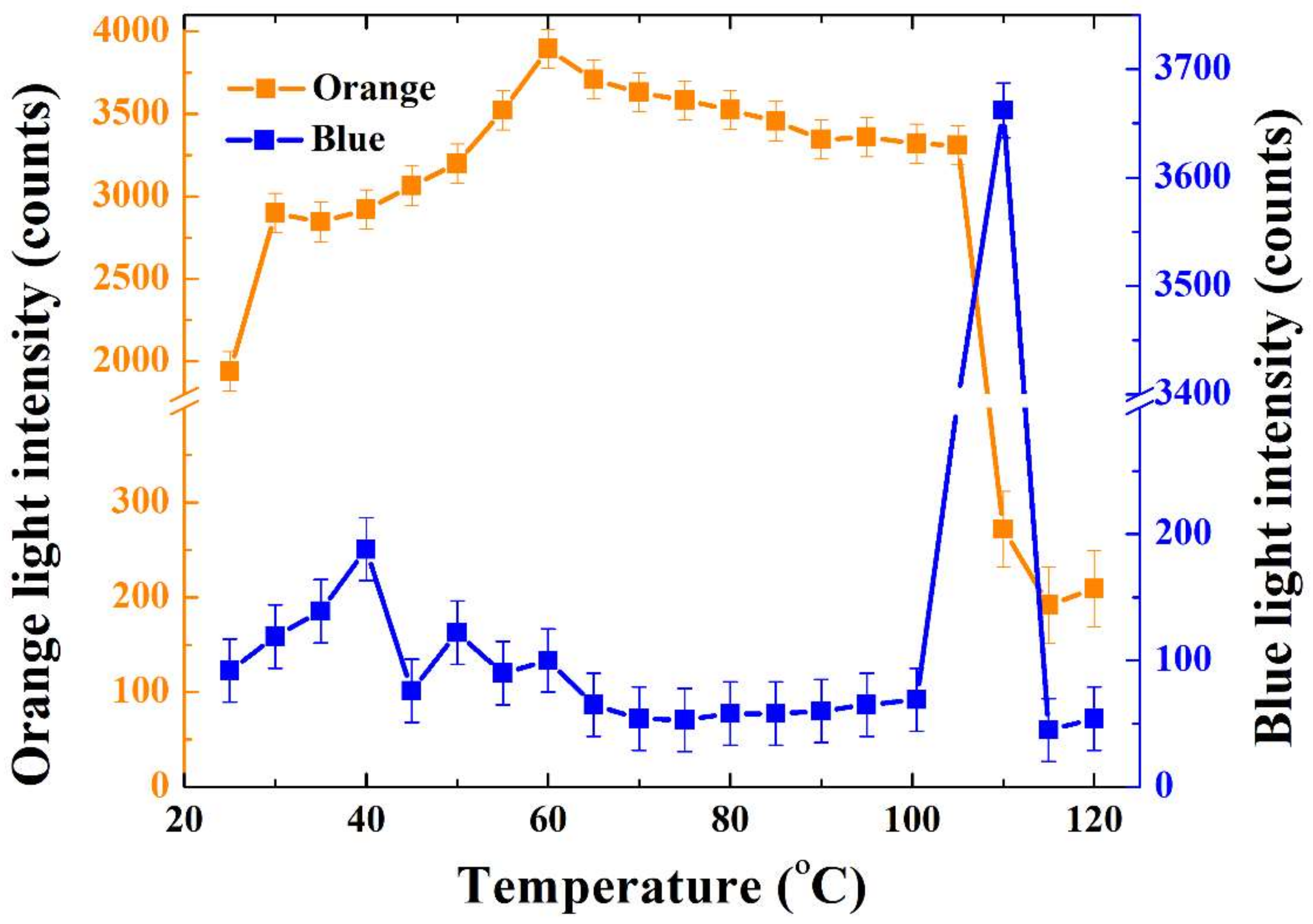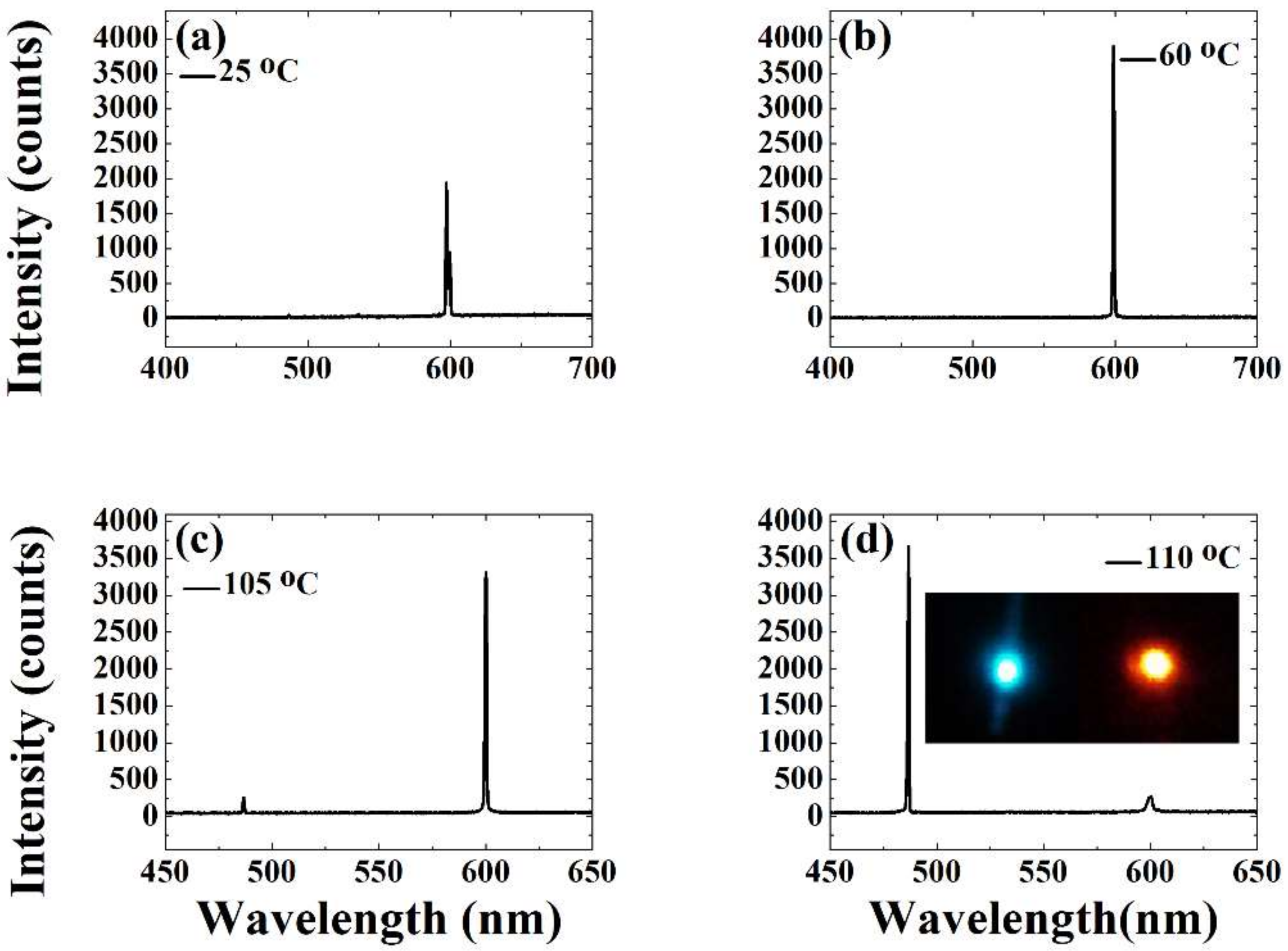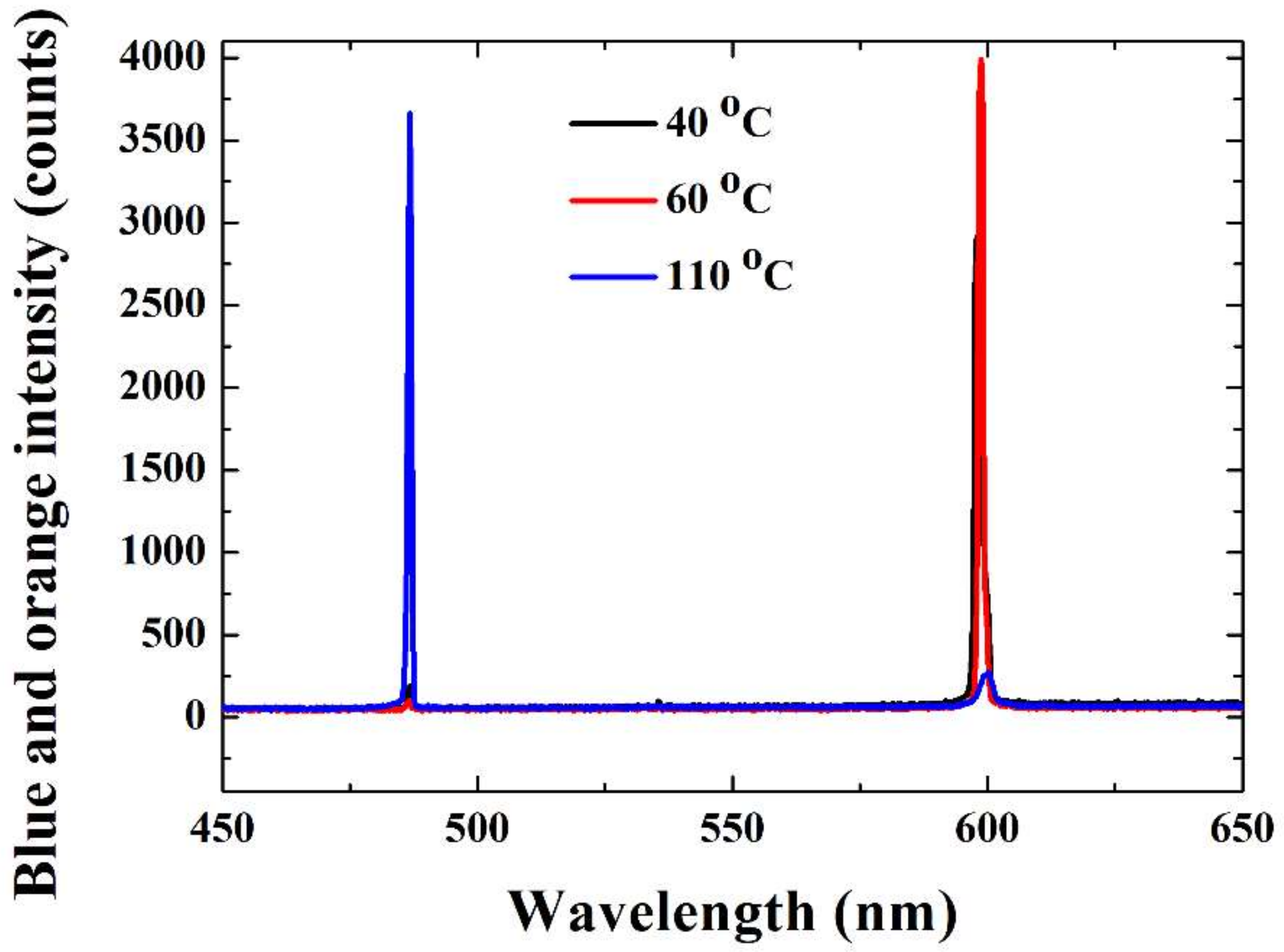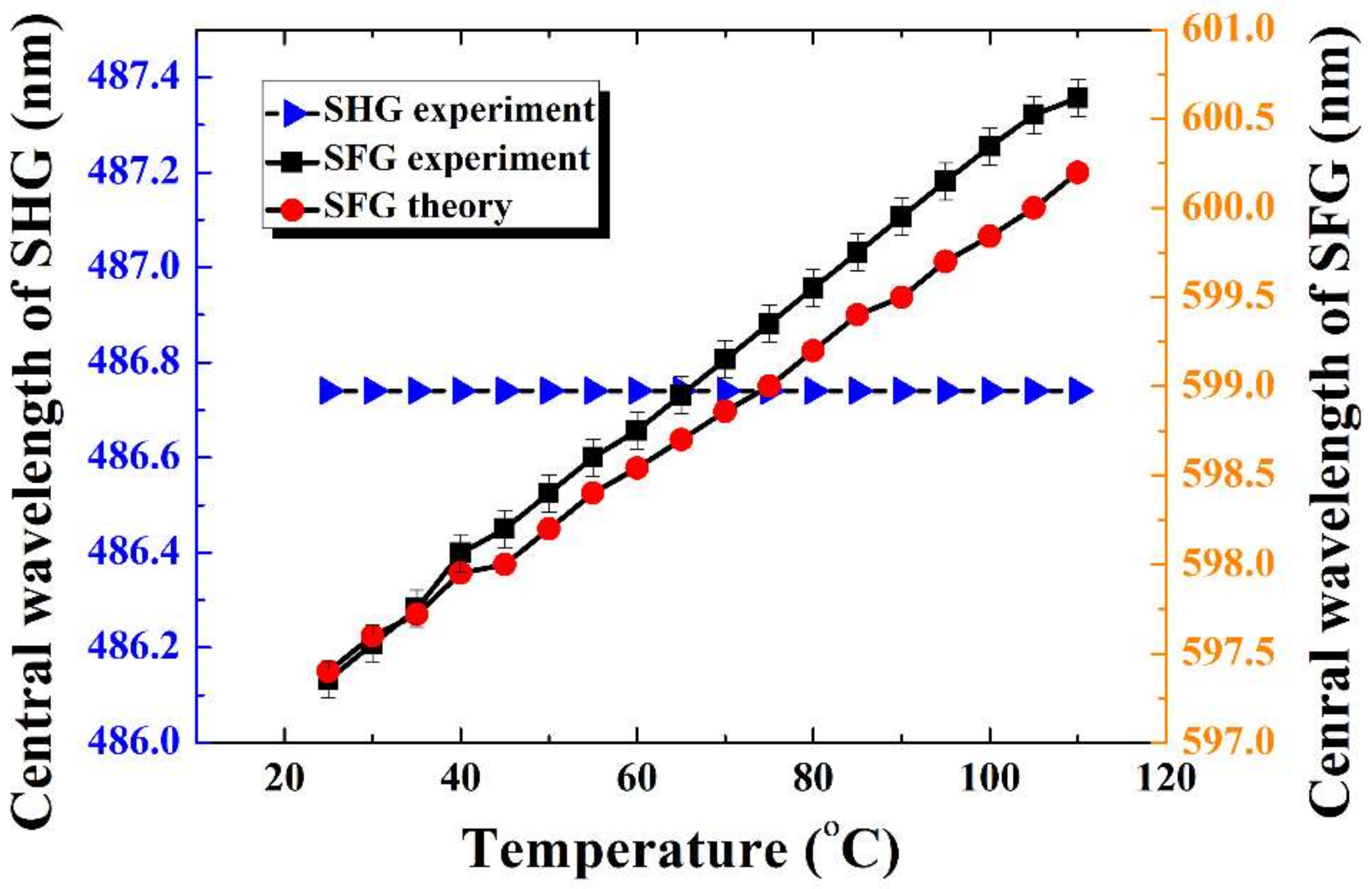Blue and Orange Two-Color CW Laser Based on Single-Pass Second-Harmonic and Sum-Frequency Generation in MgO:PPLN
Abstract
Featured Application
Abstract
1. Introduction
2. PPLN Design and Fabrication
3. Experimental Setup and Output Characterization
3.1. Experimental Setup
3.2. SFG and SHG Characterization
4. Conclusions
Acknowledgments
Author Contributions
Conflicts of Interest
References
- Johansson, S.; Spiekermann, S.; Wang, S.; Pasiskevicius, V.; Laurell, F.; Ekvall, K. Generation of turquoise light by sum frequency mixing of a diode-pumped solid-state laser and a laser diode in periodically poled KTP. Opt. Express 2004, 12, 4935–4940. [Google Scholar] [CrossRef] [PubMed]
- Kapoor, V.; Subach, F.V.; Kozlov, V.G.; Grudinin, A.; Verkhusha, V.V.; Telford, W.G. New lasers for flow cytometry: Filling the gaps. Nat. Methods 2007, 4, 678–679. [Google Scholar] [CrossRef] [PubMed]
- Xu, Z.Y.; Bi, Y. Large laser projection displays utilizing all-solid-state RGB lasers. In Light-Emitting Diode Materials and Devices; SPIE Proceedings; John Wiley &Sons Ltd.: Oboken, NJ, USA, 2005; Volume 5632, pp. 115–122. [Google Scholar]
- Mizuuchi, K.; Yamamoto, K.; Kato, M. Harmonic blue light generation in X-cut MgO:LiNbO3 waveguide. Electron. Lett. 1997, 33, 806–807. [Google Scholar] [CrossRef]
- Zhu, S.N.; Zhu, Y.Y.; Ming, N.B. Quasi-phase-matched third-harmonic generation in a quasi-periodic optical superlattice. Science 1997, 278, 843–846. [Google Scholar] [CrossRef]
- Liu, X.; Zhang, H.; Guo, Y.; Li, Y. Optimal Design and Applications for Quasi-Phase-Matching Three-Wave Mixing. IEEE J. Quantum Electron. 2002, 38, 1225–1233. [Google Scholar]
- Charbonneau-Lefort, M.; Fejer, M.M.; Afeyan, B. Tandem chirped quasi-phase-matching grating optical parametric amplifier design for simultaneous group delay and gain control. Opt. Lett. 2005, 30, 634–636. [Google Scholar] [CrossRef] [PubMed]
- Umeki, T.; Asobe, M.; Yanagawa, T.; Tadanaga, O.; Nishida, Y.; Magari, K.; Suzuki, H. Broadband wavelength conversion based on apodized χ2 grating. J. Opt. Soc. Am. B 2009, 26, 2315–2322. [Google Scholar] [CrossRef]
- Zeng, X.; Ashihara, S.; Wang, Z.; Wang, T.; Chen, Y.; Cha, M. Excitation of two-colored temporal solitons in a segmented quasi-phase-matching structure. Opt. Express 2009, 17, 16877–16884. [Google Scholar] [CrossRef] [PubMed]
- Brunner, F.; Innerhofer, E.; Marchese, S.V.; Südmeyer, T.; Paschotta, R.; Usami, T.; Ito, H.; Kurimura, S.; Kitamura, K.; Arisholm, G.; et al. Powerful red-green-blue laser source pumped with a mode-locked thin disk laser. Opt. Lett. 2004, 29, 1921–1923. [Google Scholar] [CrossRef] [PubMed]
- Capmany, J. Simultaneous generation of red, green, and blue continuous-wave laser radiation in Nd3+-doped aperiodically poled lithium niobate. Appl. Phys. Lett. 2001, 78, 144–146. [Google Scholar] [CrossRef]
- Capmany, J.; Bermúdez, V.; Callejo, D.; García Solé, J.; Diéguez, E. Continuous wave simultaneous multi-self-frequency conversion in Nd3+-doped aperiodically poled bulk lithium niobate. Appl. Phys. Lett. 2000, 76, 1225–1227. [Google Scholar] [CrossRef]
- Liao, J.; He, J.L.; Liu, H.; Du, J.; Xu, F.; Wang, H.T.; Zhu, S.N.; Zhu, Y.Y.; Ming, N.B. Red, yellow, green and blue—Four-color light from a single, aperiodically poled LiTaO3 crystal. Appl. Phys. B Lasers Opt. 2004, 78, 265–267. [Google Scholar] [CrossRef]
- Liao, J.; He, J.L.; Liu, H.; Wang, H.T.; Zhu, S.N.; Zhu, Y.Y.; Ming, N.B. Simultaneous generation of red, green, and blue quasi-continuous-wave coherent radiation based on multiple quasi-phase-matched interactions from a single, aperiodically-poled LiTaO3. Appl. Phys. Lett. 2003, 82, 3159–3161. [Google Scholar] [CrossRef]
- Gao, Z.D.; Zhu, S.N.; Tu, S.Y.; Kung, A.H. Monolithic red-green-blue laser light source based on cascaded wavelength conversion in periodically poled stoichiometric lithium tantalate. Appl. Phys. Lett. 2006, 89, 181101. [Google Scholar] [CrossRef]
- Xu, P.; Zhao, L.N.; Lv, X.J.; Lu, J.; Yuan, Y.; Zhao, G.; Zhu, S.N. Compact high-power red-green-blue laser light source generation from a single lithium tantalate with cascaded domain modulation. Opt. Express 2009, 17, 9509. [Google Scholar] [CrossRef] [PubMed][Green Version]
- Baker, K.L. Single-pass gain in a chirped quasi-phase-matched optical parametric oscillator. Appl. Phys. Lett. 2003, 82, 3841–3843. [Google Scholar] [CrossRef]
- Gayer, O.; Sacks, Z.; Galun, E.; Arie, A. Temperature and wavelength dependent refractive index equations for MgO-doped congruent and stoichiometric LiNbO3. Appl. Phys. B Lasers Opt. 2008, 91, 343–348. [Google Scholar] [CrossRef]
- Chen, B.Q.; Ren, M.L.; Liu, R.J.; Zhang, C.; Sheng, Y.; Ma, B.Q.; Li, Z.Y. Simultaneous broadband generation of second and third harmonics from chirped nonlinear photonic crystals. Light Sci. Appl. 2014, 3, 1–6. [Google Scholar] [CrossRef]
- Smith, A. SNLO Version 6.7 Nonlinear Optics Software. Available online: http://www.as-photonics.com/snlo (accessed on 27 March 2017).
- Yu, N.E.; Kurimura, S.; Kitamura, K. Higher-Order Quasi-Phase Matched Second Harmonic Generation in Periodically Poled MgO-Doped Stoichiometric LiTaO3. J. Korean Phys. Soc. 2005, 47, 636–639. [Google Scholar] [CrossRef]
- Bostani, A.; Ahlawat, M.; Tehranchi, A.; Morandotti, R.; Kashyap, R. Design, fabrication and characterization of a specially apodized chirped grating for reciprocal second harmonic generation. Opt. Express 2015, 23, 5183–5189. [Google Scholar] [CrossRef] [PubMed][Green Version]
- Powers, P.E. Field Guide to Nonlinear Optics; Greivenkamp, J.E., Ed.; SPIE: Bellingham, WA, USA, 2013. [Google Scholar]
- Georgiev, D.; Gapontsev, V.P. Watts-level frequency doubling of a narrow line linearly polarized Raman fiber laser to 589 nm. Opt. Express 2005, 13, 6772–6776. [Google Scholar] [CrossRef] [PubMed]
- Dang, W.; Chen, Y.; Gong, M.; Chen, X. Competition between SFG and two SHGS in broadband type-I QPM. Appl. Phys. B Lasers Opt. 2013, 110, 477–482. [Google Scholar] [CrossRef]
- Mehendale, S.C.; Forysiak, W.; Cheng, C.; Harrison, R.G. Influence of competition on optical sum frequency generation. Opt. Commun. 1986, 59, 304–308. [Google Scholar] [CrossRef]
- Fejer, M.M.; Magel, G.A.; Jundt, D.H.; Byer, R.L. Quasi-Phase-Matched Second Harmonic Generation: Tuning and Tolerances. IEEE J. Quantum Electron. 1992, 28, 2631–2654. [Google Scholar] [CrossRef]






© 2018 by the authors. Licensee MDPI, Basel, Switzerland. This article is an open access article distributed under the terms and conditions of the Creative Commons Attribution (CC BY) license (http://creativecommons.org/licenses/by/4.0/).
Share and Cite
Choge, D.K.; Chen, H.-X.; Xu, Y.-B.; Guo, L.; Li, G.-W.; Liang, W.-G. Blue and Orange Two-Color CW Laser Based on Single-Pass Second-Harmonic and Sum-Frequency Generation in MgO:PPLN. Appl. Sci. 2018, 8, 629. https://doi.org/10.3390/app8040629
Choge DK, Chen H-X, Xu Y-B, Guo L, Li G-W, Liang W-G. Blue and Orange Two-Color CW Laser Based on Single-Pass Second-Harmonic and Sum-Frequency Generation in MgO:PPLN. Applied Sciences. 2018; 8(4):629. https://doi.org/10.3390/app8040629
Chicago/Turabian StyleChoge, Dismas K., Huai-Xi Chen, Yi-Bin Xu, Lei Guo, Guang-Wei Li, and Wan-Guo Liang. 2018. "Blue and Orange Two-Color CW Laser Based on Single-Pass Second-Harmonic and Sum-Frequency Generation in MgO:PPLN" Applied Sciences 8, no. 4: 629. https://doi.org/10.3390/app8040629
APA StyleChoge, D. K., Chen, H.-X., Xu, Y.-B., Guo, L., Li, G.-W., & Liang, W.-G. (2018). Blue and Orange Two-Color CW Laser Based on Single-Pass Second-Harmonic and Sum-Frequency Generation in MgO:PPLN. Applied Sciences, 8(4), 629. https://doi.org/10.3390/app8040629




